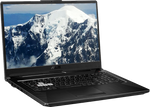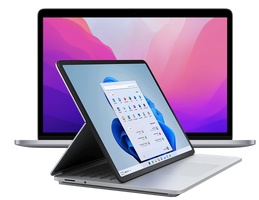A comparison of specs, key information, reviews, and best pricing from top retailers
Last updated 24 hours ago |
Report incorrect information
What we think

The PerfectRec laptop team Learn more
Updated January 10, 2024· Prices updated 24 hours ago
If portability and battery life are top priorities, the ASUS Vivobook 16 would be the better choice as it's lighter and has longer battery life. It also boasts a higher resolution screen and more storage space, making it suitable for general use and productivity tasks. However, for gaming or tasks that require a more powerful GPU like 3D rendering or intensive engineering software, the ASUS TUF Gaming F17 with its dedicated Nvidia graphics card is more appropriate despite being heavier and having a shorter battery life. Choose the TUF Gaming F17 for performance-heavy tasks or the Vivobook 16 for more casual use and ease of carrying around. Give Feedback
this description is based on the product variant with some specs and product variant with some specs. At the time of writing, the variant with some specs cost some dollars and the variant with some specs cost some dollars.
Advantages of the ASUS TUF Gaming F17
- Good speakers
- Good keyboard
Advantages of the ASUS Vivobook 16
- Good for engineering and design
- Good for software development
- Good portability
- Good battery life
Key differences
General Use
7.1


7.6
1920 x 1080
RESOLUTION
1920 x 1200
IPS
DISPLAY TECHNOLOGY
IPS
264.0 nits
DISPLAY BRIGHTNESS
295.0 nits
4.5 Hours
BATTERY LIFE
8.0 Hours
7.0/10
KEYBOARD QUALITY SCORE
6.7/10
6.4/10
PORTABILITY SCORE
7.5/10
The ASUS Vivobook 16 and ASUS TUF Gaming F17 are both good for general use, though the ASUS Vivobook 16 is somewhat better.
The ASUS Vivobook 16, with more RAM and a higher resolution and brighter screen, offers a better experience for general use, and its lighter weight and longer battery life make it more portable than the ASUS TUF Gaming F17, which, although having a powerful CPU and GPU for gaming, is heavier with a shorter battery life, making it less optimal for everyday tasks on the go.
Software Development
6.7


7.3
6.2/10
OVERALL CPU SCORE
6.9/10
8.0 GB
RAM
16.0 GB
1920 x 1080
RESOLUTION
1920 x 1200
7.0/10
KEYBOARD QUALITY SCORE
6.7/10
The ASUS Vivobook 16 is good for software development, while the ASUS TUF Gaming F17 is only fair.
PerfectRec’s Software Development Score takes into account the many different features of the laptop that make it more or less suitable for software developers.
Screen Quality
6.9


6.4
17.3in
SIZE
16.0in
1920 x 1080
RESOLUTION
1920 x 1200
IPS
DISPLAY TECHNOLOGY
IPS
144Hz
REFRESH RATE
60Hz
264.0 nits
BRIGHTNESS
295.0 nits
The ASUS TUF Gaming F17 has a better screen than the ASUS Vivobook 16 for general use, gaming and AI, and engineering and design, while the ASUS Vivobook 16 has a better screen for content creation, and software development.
For general use, the ASUS TUF Gaming F17 offers a screen that is bright and clear with good resolution, making it a solid choice for everyday tasks and media consumption, whereas the Vivobook 16 provides adequate visibility and detail but may not be as vibrant. In the context of engineering and design, the TUF Gaming F17's screen covers a wider range of colors providing more accuracy for detailed work, but both laptops have only fair performance due to limited color gamut coverage compared to specialized workstations. For gaming and 3D applications, the TUF Gaming F17 is hindered by its lower refresh rate, which can affect the smoothness of motion; meanwhile, both laptops will present challenges with less than optimal refresh rates and moderate resolution and panel type, which are critical for a more immersive and responsive experience in fast-paced games and 3D simulations.
Battery
4.5 Hours


8.0 Hours
The ASUS TUF Gaming F17 has 4.5 hours of battery life. The ASUS Vivobook 16 has 8 hours of battery life.
Battery life estimate is based on a mix of common use patterns. More portable and higher performing laptops tend to have less battery life.
Portability
Fair


Good
17.3in
SIZE
16.0in
5.7 lbs
WEIGHT
4.1 lbs
0.9in
THICKNESS
0.7in
The ASUS Vivobook 16 has good portability, while the ASUS TUF Gaming F17 has only fair portability.
The most portable laptops are small, thin, and light.
Cost
$1,000


$629
$200
$400
$600
$800
$1,000
$1,200
$1,400
$1,600
The ASUS TUF Gaming F17 has a price of $1,000 and the ASUS Vivobook 16 costs $629.

Let Us Help Find Your Perfect Laptop
Find your new laptop
Key similarities
Gaming and AI
6.6


6.3
5.2/10
OVERALL GPU SCORE
3.6/10
1920 x 1080
RESOLUTION
1920 x 1200
144Hz
REFRESH RATE
60Hz
Yes
SUPPORTS DLSS
No
No
MUX SWITCH / ADVANCED OPTIMUS
No
7.5/10
FAN NOISE SCORE
7.5/10
The ASUS TUF Gaming F17 and ASUS Vivobook 16 are both only fair for gaming and AI.
The ASUS TUF Gaming F17 is a decent option for gaming and 3D because it features a dedicated Nvidia RTX 3050 Ti GPU and a 144Hz screen refresh rate, which are very important for smooth and responsive game play. On the other hand, the ASUS Vivobook 16, while also fair for gaming and 3D, has an integrated AMD Vega 8 GPU and a lower 60Hz screen refresh rate, making it less optimal for fast-paced games despite its better screen quality.
Engineering and Design
6.9


7.0
6.2/10
OVERALL CPU SCORE
6.9/10
5.2/10
OVERALL GPU SCORE
3.6/10
8.0 GB
RAM
16.0 GB
Although they have very similar scores, PerfectRec considers ASUS Vivobook 16 to be good for engineering and design, while the ASUS TUF Gaming F17 is only fair.
PerfectRec’s Engineering and Design Score takes into account the many different features of the laptop that make it more or less suitable for graphic design and 3D rendering work.
Content Creation
7.1


7.5
6.2/10
OVERALL CPU SCORE
6.9/10
1920 x 1080
RESOLUTION
1920 x 1200
8.0 GB
RAM
16.0 GB
IPS
DISPLAY TECHNOLOGY
IPS
The ASUS Vivobook 16 and ASUS TUF Gaming F17 are both good for content creation.
PerfectRec’s Content Creation Score takes into account the many different features of the laptop that make it more or less suitable for photo editing, video editing and other content creation tasks.
Build Quality
7.2


7.0
The ASUS TUF Gaming F17 and ASUS Vivobook 16 both have good build quality.
PerfectRec’s Build Quality Score incorporates case materials, display and keyboard flex, hinge quality, and overall reliability.
Give feedback
We’re constantly working to improve.
How the ASUS TUF Gaming F17 and the ASUS Vivobook 16 compare to other laptops
Spec Comparison
| ASUS TUF Gaming F17 | ASUS Vivobook 16 |
GENERAL | |||
|---|---|---|---|
| Price | |||
$1,000 | $629 | ||
Release Date | |||
Release Date | May 1, 2022 | May 1, 2023 | |
Overall Dimensions | |||
Overall Dimensions | 15.7'' x 10.6'' x 0.91'' | 14.1'' x 9.8'' x 0.78'' | |
Weight | |||
Weight | 5.73 lbs | 4.14 lbs | |
Width | |||
Width | 15.71" | 14.12" | |
Depth | |||
Depth | 10.59" | 9.82" | |
INTERNAL | |||
|---|---|---|---|
Processor | |||
Processor | Intel i5-11400H | AMD Ryzen 7 7730U | |
RAM | |||
RAM | 8 GB | 16 GB | |
DDR Memory Version | |||
DDR Memory Version | 4 | 5 | |
RAM Slots | |||
RAM Slots | 2 | 1 | |
Storage | |||
Storage | 512 GB | 1024 GB | |
BATTERY | |||
|---|---|---|---|
Battery Life | |||
Battery Life | 4.5 Hours | 8 Hours | |
Battery Capacity | |||
Battery Capacity | 48 Wh | 42 Wh | |
SCREEN | |||
|---|---|---|---|
Diagonal Size | |||
Diagonal Size | 17.3" | 16" | |
Display Technology | |||
Display Technology | IPS | IPS | |
Resolution | |||
Resolution | 1920 x 1080 | 1920 x 1200 | |
Refresh Rate | |||
Refresh Rate | 144Hz | 60Hz | |
Display Brightness | |||
Display Brightness | 264 nits | 295 nits | |
RELIABILITY, APPEARANCE & ACOUSTICS | |||
|---|---|---|---|
Build Quality Score | |||
Build Quality Score | 7.2/10 | 7/10 | |
Portability Score | |||
Portability Score | 6.4/10 | 7.5/10 | |
Gaming Laptop Appearance | |||
Gaming Laptop Appearance | Yes | No | |
Premium Business Laptop | |||
Premium Business Laptop | No | No | |
Fan Noise Score | |||
Fan Noise Score | 7.5/10 | 7.5/10 | |
HARDWARE FEATURES | |||
|---|---|---|---|
Keyboard Quality Score | |||
Keyboard Quality Score | 7/10 | 6.8/10 | |
Speaker Quality Score | |||
Speaker Quality Score | 7.5/10 | 6/10 | |
Webcam | |||
Webcam | 720p | 720p | |
Fingerprint Reader | |||
Fingerprint Reader | No | Yes | |
Backlit Keyboard | |||
Backlit Keyboard | Yes | Yes | |
Number Pad | |||
Number Pad | Yes | Yes | |
CONNECTIVITY | |||
|---|---|---|---|
USB Type-A | |||
USB Type-A | 3 | 3 | |
USB-C ports | |||
USB-C ports | 1 | 1 | |
USB-C Charging | |||
USB-C Charging | No | Yes | |
Display Outputs | |||
Display Outputs | 2 | 1 | |
Thunderbolt Ports | |||
Thunderbolt Ports | 0 | 0 | |
Shopping
ASUS TUF Gaming F17
See more
Dig into reviews and images
NotebookCheck
Christian Hintze | April 2022
"One of the Asus TUF Gaming F17’s highlights is without a doubt its excellent gaming performance. The fact that Asus configured the RTX 3060 GPU for its specified maximum of 140 W is became immediately noticeable in our benchmarks. For a 17-inch notebook the F17 also offers a very long battery life, which makes it somewhat portable. On the flip side is the display. It may be saved by its good overall contrast ratio, but its overall brightness is simply too low, and its response times are too slow for a gaming device. The F17’s successor needs to improve upon this."
ASUS Vivobook 16
See more
Dig into reviews and images
Rtings
Olivier Martin, Ryan Lim, Yannick Khong | May 2023
"The ASUS Vivobook 16 M1605 (2023) is a budget Windows laptop. It's available with various AMD Ryzen 5000 and 7000 U-series CPUs and integrated graphics. You can only get 8GB of RAM; however, there's an empty SO-DIMM slot if you want to upgrade it. It has an FHD+ (1920 x 1200) 16:10 IPS display, a full-size keyboard with a Numpad, a 720p webcam, and Wi-Fi 6E wireless connectivity. Ports include three USB-As, one USB-C, an HDMI, and a headphone jack. The USB-C supports charging but no video output."
Get a great deal on the ASUS TUF Gaming F17 or the ASUS Vivobook 16
0
About ASUS
ASUS, a Taiwanese electronics brand, is one of the largest personal computer vendor by market share. The majority of their laptops are targeted towards personal use or gaming. Their most popular product lines include the budget-friendly VivoBook, more premium ZenBook, and their TUF and ROG gaming laptops, the latter of which has a reputation for excellent gaming performance.
Give feedback
We're constantly perfecting our model
Laptop guides you might be interested in
More comparisons for you
FAQs
FAQs about laptops
Why trust us
This information was produced and vetted by the PerfectRec laptops team. We are a product research and recommendation organization that meticulously reviews and evaluates the latest laptop information and makes it digestible for you.
By the numbers
380
Laptops evaluated
48,640
Laptops stats compiled
13
Proprietary Laptops ratings developed
173,595
Recommendations made
37,613
Consumer hours saved
About the laptop team
Joe Golden, Ph.D
CEO and Laptops Editor
Joe is an entrepreneur and lifelong electronics enthusiast with a Ph.D in Economics from the University of Michigan.
Jason Lew
Staff Expert & Software Engineer
Jason is a staff expert and software engineer that has been making laptop recommendations for 7 years and moderates one of the largest laptop subreddits.
Chandradeep Chowdhury
Staff Expert & Software Engineer
Chandradeep is a staff expert and software engineer and expert in televisions and monitors. He’s been making monitor recommendations for ten years.
Craig Russell
Laptops Expert
Craig is a UK-based laptops expert. Craig works in IT, where he recommends and supports laptops and PCs for clients and has been recommending laptops on Reddit for five years.







